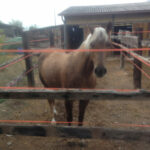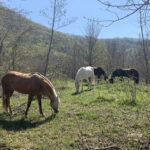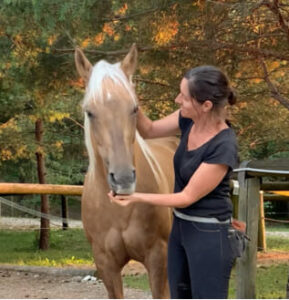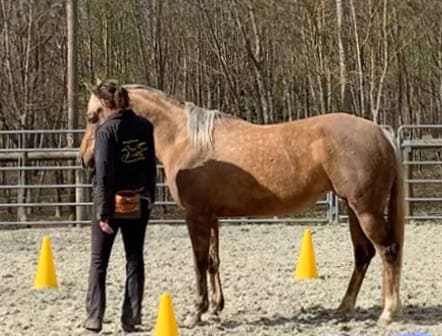Following a systematic training plan can drastically improve the relationship with your horse. Even a fearful or aggressive horse can turn into a partner who is eagerly waiting for you at the pasture gate.
But how?

Blondie was three years old when I met her. She lived in a very impoverished environment: box with small paddock, no turnout.
She was started as a very young horse in a ‘Do-it-or-else’ environment and turned into a compliant ‘soldier’ without sparkle in her eyes. Many horse people would call that ‘well behaved’.
Blondie coped by escaping into crib-biting, which is why I began working with her in 2016 for an MSc thesis on crib-biting under the guidance of Dr Jesús Rosales-Ruiz.
In a nutshell, the study results showed that Blondie’s crib-biting could be influenced by changing environmental conditions, which opens the possibility for operant procedures.
This is important!
Said differently, this means that, in principle, it is possible to change the behavior with training.
Current explanations focus on pathologies, e.g. gastrointestinal tract disorders or neurophysiological changes. Unfortunately, they don’t offer a solution other than often unsuccessful measures such as environmental enrichment, physical restraint, or surgery.
But I don’t want to elaborate on the cribbing study here (read about it here). I want to point out, though, that her owner could not tolerate the cribbing and tried various things to stop the behavior.

The use of a cribbing collar may have caused partial facial paralysis. As a result, Blondie’s right ear and lower lip dropped slightly, and she was close to losing her right eye. In addition, she has lost sensation in her right cheek, which we discovered through bite marks on her inner cheek.

In face of these problems, the owner decided to get rid of her, a fate many cribbers share. Thankfully, with the help of the clicker training community, I raised enough funds to add her to our little herd. MANY THANKS AGAIN ❤️
Now that I started handling her daily, I soon realised that underneath that complying soldier was a precious gem waiting to be uncovered and polished.
However, it’s never as simple as that.
When punishment and intimidation are no longer occurring, previously suppressed behaviour comes back to the surface.
It is frustrating when you have rescued an animal and, in return, that individual responds with aggressive behaviour.
You shower your horse with affection, and all you get is pinned ears, threats to bite or kick, running away or rearing. That’s not how you imagineded the relationship.
But never give up on your horse.
She shows you her experience from the past, not the present.
There are ways to overcome this extinction burst. The most important points are to be NON-REACTIVE to these behaviors and STAY SAFE.
I started in protective contact, i.e. in a training environment with a solid barrier between us. This setting provided safety to both of us.
As we progress in the training, I ALWAYS make sure that she stays in her comfort zone.
I may be changing something in the environment or increasing criteria for reinforcement but I always observe if these changes have introduced tension or hesitation. If they did, I adjust the training plan immediately.
Here’s an example:
Pretty early on when transitioning to clicker training, Blondie went through a two-week-long “Teenager explosion”. Punishment was no longer a threat and she said “No” to many things. Sometimes unexpected.
Here’s a clip showing one of her “Teenager moments”
Accordingly, I needed to come up with a training plan to teach haltering under different conditions. I noticed that she was calmer in the paddock. That’s where we did the training.
You are currently viewing a placeholder content from Default. To access the actual content, click the button below. Please note that doing so will share data with third-party providers.
Initiating our interaction in a new context, i.e in the context of clicker training, has ripple effects on the entire training session that follows. I am not “competing” with previous experiences. Instead, we begin in a positive mindset right off the start.
Following the same logic, I have trained many new behaviours: leading, saddling, bridling, mounting and riding as a whole.
This CONSISTENCY transformed the relationship with Blondie.
Blondie is no longer the shut down little soldier following orders. Instead, she has grown into a confident and beautiful mare with sparkling eyes.

We are working on both emotional and physical balance, and even though we have not yet started “serious” physical work, the effect of thoughtful training already shows in her balance and posture.




At this point, you are probably wondering: Ok, but HOW! Tell me the details! I hear you. Let me go from the bigger picture describing the principles to more examples and details.
The bigger picture
Our horses respond to the environmental conditions (remember that YOU are part of your horse’s environment). If these conditions change, their behaviour will adapt. Behaviour always occurs in a context.
We need to analyse our horse’s behaviour in the context where it occurs.
To do that, we first need to define behaviour. For example, in ‘Non-linear contingency analysis’, Joe Layng et al. define it as follows:
We define behaviour as a change in the RELATION between an ORGANISM and its ENVIRONMENT as measured by an investigator.
Note that an investigator is any person who measures these changes and is not limited to scientists. So if you take note of these changes, then you are the investigator.
These relations include “voluntary” physical movements, such as walking, and “involuntary” physiological activities, such as body language related to emotional states or the release of hormones or neurotransmitters.
This “if/then” relation between behaviour and its consequences in a given environmental context is called a consequential contingency.
Think of it as a contingency plan. For example, IF I see dark clouds in the sky as I look out of the window, THEN I pick up an umbrella as I leave the house. IF it rains as I walk to work, THEN I open the umbrella to stay dry. IF the sky clears up, THEN I keep the umbrella folded up in my purse.
Another critical piece to understand is that EMOTIONS track the contingencies in place. Therefore, when the contingencies change, the emotions and thoughts that are a part of that contingency may also change. (For a deep dive, read this article by Joe Layng).
Here’s an example:
You want to pull a prank on your sibling. You are hiding behind the veranda door with a water pistol in hand, ready to shoot. You are eagerly awaiting your sibling’s arrival anticipating laughter, followed by a fun game in the pool. You hear steps, and you squirt the water in the face only to find out that it was your parent who had previously asked you to stop the game. The consequential contingency changed from laughter to scolding, and so did your emotions.
Let’s look at some horse training
Remember the four questions of the constructional program?
1. Where do you want to go from here?
Ask yourself, if everything goes perfectly well, what would your horse be doing? What will others see if they observe your perfect horse?
On a first try, you might say things like: “I’d be happy if my horse would just not kick against the door”, but you don’t see “not kicking”. What would you see? Standing calmly at the gate, observing you as you approach with the feeding bucket?
To answer this question, you are allowed to DREAM BIG. What does your PERFECT HORSE look like? What does she DO?
Example: Leading skills
My perfect horse responds to my signals through the lead rope when I ask her to come forward, slow down, halt, back or turn. She does so promptly, calmly and in good balance (remember to dream big).
2. Where are you now?
This question is critical to identify your starting point. It collects information about SKILLS you and your horse already HAVE. It also establishes under which conditions the problem is not a problem.
You may not know the answers to those questions right away. Actually, it may be safer to assume that you don’t.
How can you find out? Take an experimental approach.
Split up the process into its elements and conduct an experimental investigation for every component.
Example: Leading skills
How does perfect leading look ? What are the individual elements of that process? Which questions do you need to ask your horse? The exact list of questions will depend on the answers you get from your horse.
As you go through the process, assess whether your horse stays relaxed throughout or is there a step where she is hesitant or getting tense? Explore that step in more detail.
- Can I approach the stall?
- Can I open the stall door?
- Can I touch your head and neck?
- Can I put on the halter and take it off?
- Can I touch your neck in the presence of a lead rope?
- Can I touch your neck while holding a lead rope in my other hand?
- Can I attach the lead rope to the halter and let it rest on your back?
- Can I pick up the lead rope and drop it back?
- Can I pick up the lead rope, hold it, and put it back?
- Can I pick up the lead rope, slide up a hand’s width, slide back and rest it on your back? etc.
This may look like a training plan, but you are only taking a baseline at this stage. You are not training yet.
Going through these individual steps will help you identify where your horse has questions.
For example, your horse may be comfortable with you approaching and stroking his head and neck UNTIL you come with a halter and lead rope in your hand.
You can only find out if you run a little experiment changing one variable at a time and observing your horse’s behavior. If there is a behaviour change, you may have identified your starting point.
Here’s a great video of the process.
You are currently viewing a placeholder content from Default. To access the actual content, click the button below. Please note that doing so will share data with third-party providers.
3. How can you get there?
This part defines the training plan from the current repertoire to the target repertoire. Your training plan considers the answers your horse gave you in the previous step.
Your starting point is where you and your horse are already successful!
The cool thing is that by going through the process in step 2, you have not only found the strengths and weaknesses of your current skill set, but you have also improved it without even realising.
As you go through the process of, e.g. picking up the lead rope mindfully and setting it back down, you have practised and refined that skill. Your horse will already be happier the next time you pick up the lead rope.
Now that you know your starting point, you use shaping and transferring to new situations to build the behaviour identified in step 1.
Shaping
There are different definitions for Shaping used in the training community and then there are variations used in science. I like the practical explanation that Mary Hunter and Jesús Rosales-Ruiz use in PORTL (Portable Operant Research and Training Laboratory). In their manual they write:
Shaping means teaching the behavior using a series of steps, instead of expecting the learner to do the whole behavior at once. […] The teacher starts by reinforcing a particular behaviour the learner can already do. […] Each new step is presented in a way that makes it easy for the learner.
Mary Hunter and Jesús Rosales-Ruiz provide the image of shaping as a ‘straw’ as opposed to a ‘funnel’. A funnel model would initially reinforce any behaviour that resembles the final behaviour and then go through an extinction process to get the desired behavior. The ‘straw’ model instead starts at a very precise detail of the target behaviour that the learner can already do and is then extended and combined.
Alexandra Kurland wrote a great blog article (among many) that compares these two models. In the same article, she describes what she calls “loopy training”, which is a very elegant way of explaining the principle of starting where your learner is already successful and expanding the “loop” in small increments that learning is easy and fast.

Shaping foundations
Mary Hunter and Jesús Rosales-Ruiz describe six foundations skills for shaping in PORTL which are equally important for horse training (for details consult their website Behavior Explorer).
- Resets bring your learner back to a starting point so that he/she can repeat the behavior. This is immensely important and really deserves an entire article to give it justice. But let’s just leave it for now and continue…
- Targeting gives directional clues. It is often the first lesson we teach our horse when introducing clicker training and then used in a trillion different ways in your training progression.
- Capturing actions: certain actions are more likely under certain conditions (objects, location, even balance distribution). For example, if you hold a feeding bucket in front of your horse, he is probably dipping his nose into it. If your horse is looking to his right, you will find it difficult to pick up his left front leg as he has all his weight on it.
- Transferring actions: Actions can be transferred from one object to another which can help you to teach “unlikely” behaviors. Strategically, you may choose to ‘capture’ an action in a setting where it is likely to occur, e.g. rolling in the sandpit after a bath and ‘transfer’ that action to another setting, e.g. riding school
- Changing criteria for reinforcement: To shape effectively, you need to be able to move between steps at a speed that is not too fast or too slow for your learner.
- Chaining: building sequences of two or more behaviors.
Example for transferring action: Bridling
Taking a baseline on bridling, Blondie showed a clear hesitation to take the bridle. In the past, I would have taken a linear shaping approach, i.e. reinforce small approximations to the desired outcome. For example, I would have marked and reinforced sniffing the bit, then touching the bit etc.
Instead, I started with a behavior she knows and likes and transferred that to other objects.
Blondie enjoys fetching her toy. It was one of the first things I taught her with clicker training. So I transferred the action ‘taking into mouth’ from fetch toy to rubber bit to plastic bit to final snaffle bit.
You are currently viewing a placeholder content from Default. To access the actual content, click the button below. Please note that doing so will share data with third-party providers.
4. What keeps you going?
Replies to this question are individual, but I assume that being successful and seeing your horse happy, engaged, relaxed, and in good balance is reinforcing for all of us and keeps us motivated to learn more.
Here is the result of going carefully through the process of constructional training using the example of saddling.
Blondie was really quite unhappy about saddling when I first tried. I went through a constructional program to teach her a new saddling behavior. The entire program contained many “mini-programs”, each with its own baseline and teaching plan, too many to describe here. In a nutshell, I went through all the steps described in detail above.
- Where do you want to go from here? I want Blondie to stay calm and relaxed while being saddled.
- Where are you now? Taking many baselines in a systematic manner, I could identify starting points and develop a training plan for each component.
- How can you get there? Using shaping and transferring actions to new objects and settings, I could build a new saddling behavior.
- What keeps you going? Seeing the transformation in Blondie’s expression from being stressed to relaxed, from avoiding to approaching.
You are currently viewing a placeholder content from Default. To access the actual content, click the button below. Please note that doing so will share data with third-party providers.
Are you ready for more?
Cool!
Now that we went through the process once, let’s look at some more details and practical examples. Read on here…
